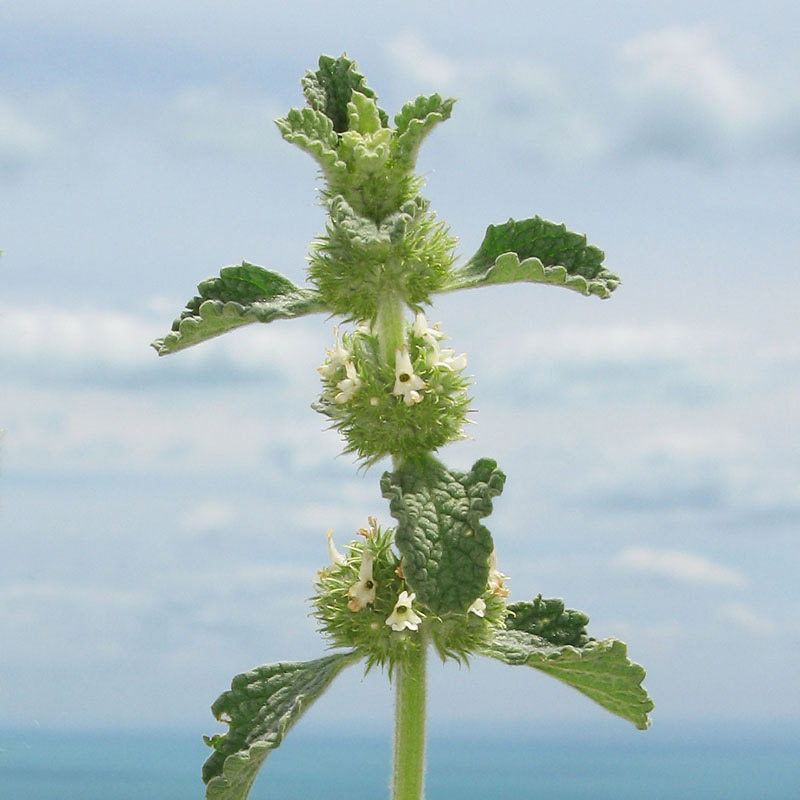Botanical name
Marrubium vulgare L.
Family
Lamiaceae
Common name
White horehound, Common horehound, Horehound
Information about the plant
White horehound is native to warmer climates from the Mediterranean to Central Asia and has naturalized in Central and Northern Europe. The heat-loving plant grows along paths and walls, on rubble and wasteland. It is considered to be threatened with extinction. The herbaceous plant does not have thorns, with the hooked withering tips of the sepals remaining attached to clothing in the fall. The generic name Marrubium originally derives from the Hebrew ‘mar’ (=bitter) and ‘rob’ (=much), adopted into Latin as ‘marrubius’ (=mountain hops). This alludes to the bitter taste of the plant. The species epithet “vulgare” originates from Latin and means ‘common’.
White horehound typically reaches a height of 20 to 60 cm, sometimes in the form of a semi-shrub. On the four-edged, white-felt hairy stem are situated cross-opposed reticulate leaves with white-felt hair, especially on the underside and roughly irregularly toothed margins. The small white labiate flowers sit densely in spherical appearing leaf axillary false whorls, with 6 to 8 per stem. The white corolla has downy hairs; its labellum is distinctly medium-pinnate. The calyx is particularly striking, with 10 teeth that curve hooked at the tip during fruiting time. Blooming occurs from June until September.
Medicinally used parts of plants (herbal drug)
The dried above-ground parts collected during the flowering period are used, consisting of leaves, flowers, and stems (White horehound – Marrubii herba).
The traded drug comes from cultivation in Southeast European countries, as well as France and Morocco.
Constituents of the herbal drug
White horehound contains diterpene bitterns, flavonoids, phenylpropane derivates, and lamiaceae tannin.
Quality of the drug
The quality of White horehound (Marrubi herba) is specified in the European Pharmacopoeia (Ph. Eur.).
Medical applications
Recognised medical use
The HMPC has classified White horehound as a traditional herbal medicinal product (“traditional use”).
ESCOP: against loss of appetite and digestive complaints such as bloating and flatulence; catarrh of the upper airways. These applications are supported by evidence of long-term use in humans.
Traditional use
White horehound has been classified by the HMPC as a traditional herbal medicinal product (§ 39a AMG). Based on many years of experience, White horehound can be used as a mucolytic agent (expectorant) for coughs associated with colds; furthermore, it can also be used for mild dyspeptic complaints such as bloating or flatulence as well as temporary loss of appetite.
Herbal drug preparations in finished dosage forms
- Cut White horehound for tea preparations
- Fluid extract for liquid preparations
- Aqueous decoction in liquid preparations
- Freshly expressed plant juice
Dosage
Finished dosage form: see package leaflet.
Tea infusion: Consume a cup of warm White horehound tea 3 times a day; also combined with other drugs e.g. wormwood, gentian root, yarrow herb or centaury (stomach teas). To stimulate appetite, the tea should be drunk half an hour before meals; for digestive complaints, the tea should be drunk after meals. Daily dose: 4 to 6 g of drug.
Preparation of a tea
Pour 1 to 2 g of finely chopped White horehound over 150 ml of hot water and strain after 10 min.
Notes
White horehound must not be taken in the presence of gastric and duodenal ulcers. In the presence of gallstones or gall complaints, medical advice should be sought.
There are no safety studies on the use of White horehound during pregnancy and lactation; use in children under 12 years of age is not recommended due to lack of data.
Side effects
None known
Interactions
None known
References
Herbal drug monographs
HMPC (2013,2022), ESCOP (2013)
Further literature
Commentary on the European Pharmacopoeia (Andornkraut, Nr. 1835)


